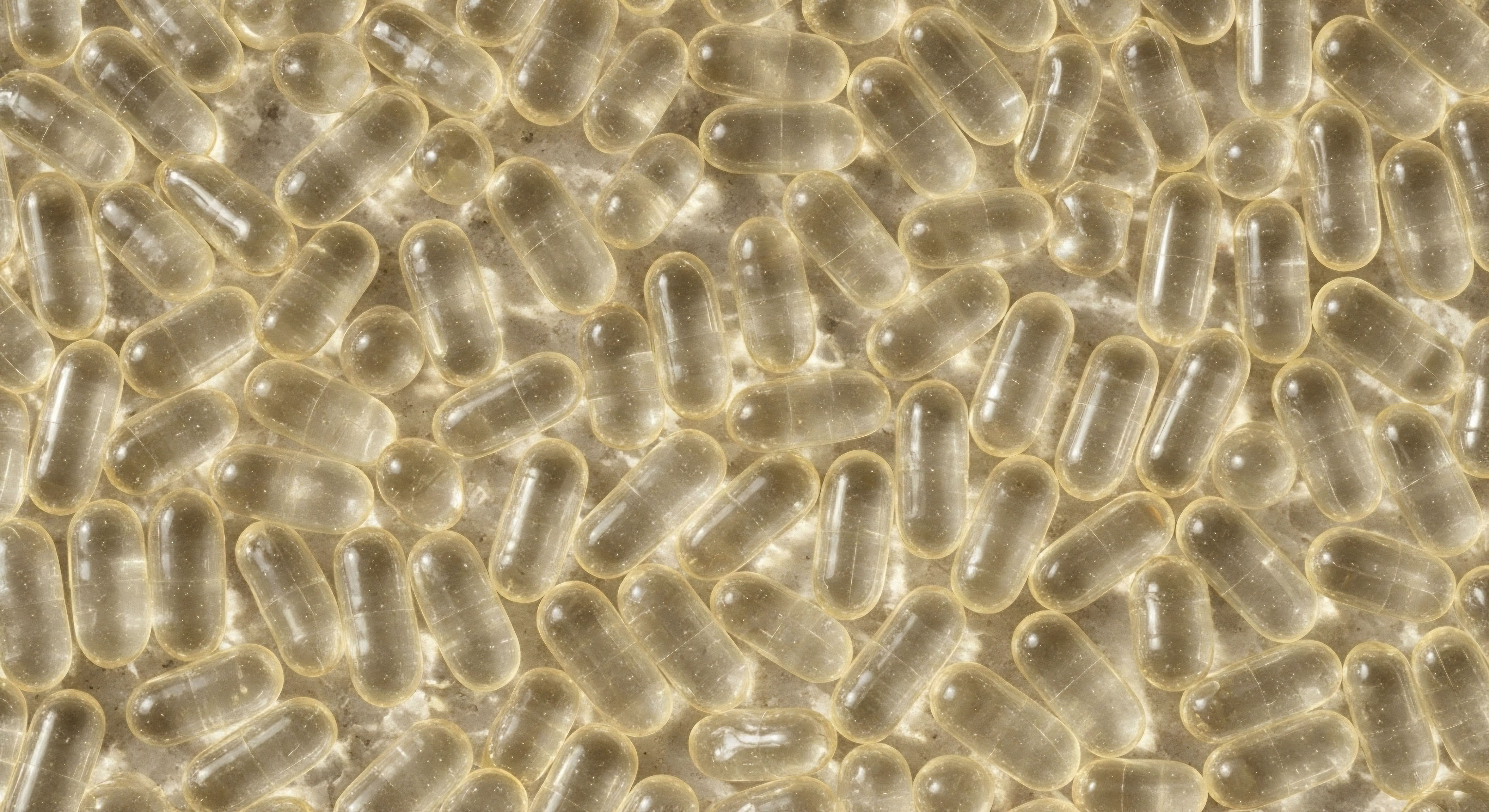

Fundamentals
You may have arrived here holding a piece of paper, a lab report, with a number next to the word “Estradiol.” For many men, seeing this result, often labeled as a “female hormone,” can be a source of immediate confusion and concern. The feeling is valid.
It stems from a deeply ingrained, yet biologically incomplete, narrative about male and female physiology. Your experience of questioning that number is the correct first step on a more sophisticated path to understanding your own body’s intricate operating system.
The journey to reclaiming your vitality begins with moving past simplified labels and appreciating the profound role of specific molecules in your health. Estradiol is one such molecule, a key that unlocks numerous aspects of male function, from cognitive clarity to physical power.
To truly grasp what an optimal estradiol level means for you, we must first understand where it comes from. Your body produces testosterone, the principal male androgen, primarily in the testes. A significant portion of this testosterone serves as a raw material for the production of estradiol.
This conversion happens throughout your body ∞ in fat tissue, in bone, in the brain ∞ facilitated by an enzyme called aromatase. Think of aromatase as a highly specialized artisan. It takes the foundational material of testosterone and skillfully transforms it into estradiol, a compound with its own unique and essential set of tasks. This biological process is a fundamental feature of male physiology. It is the body’s innate method of creating a delicate, powerful balance required for peak function.

The Purpose of Estradiol in Male Biology
Estradiol’s presence in the male body is a matter of intentional biological design. It operates as a critical signaling molecule, binding to specific estrogen receptors located in cells throughout your body. These receptors are densely concentrated in areas responsible for functions you intuitively recognize as vital to your well-being. Appreciating these roles is central to understanding why a specific range is so important for your health.

Brain and Cognitive Function
Your brain is rich with estrogen receptors. Estradiol plays a direct role in modulating libido, mood, and cognitive acuity. It influences the production and activity of neurotransmitters like serotonin and dopamine, which are central to feelings of well-being and motivation.
When estradiol levels fall outside of their optimal range, men often report a decline in sexual interest, increased irritability, or a sense of brain fog. The clarity and drive you feel are, in part, orchestrated by the proper balance of this very hormone.

Cardiovascular System Support
The health of your heart and blood vessels is also connected to estradiol. It contributes to the healthy functioning of the endothelium, the inner lining of your arteries. Proper estradiol levels are associated with more favorable lipid profiles, including the balance of cholesterol types. This molecular messenger helps maintain a resilient and responsive cardiovascular system, which is a cornerstone of long-term health and physical performance.
Estradiol is not a foreign substance but a vital, internally produced molecule essential for male brain, bone, and sexual health.

Bone Strength and Integrity
One of estradiol’s most critical roles in men is the maintenance of bone mineral density. Testosterone provides a foundation for bone health, yet estradiol is the primary signal that regulates the rate of bone turnover. It slows the breakdown of old bone tissue, a process managed by cells called osteoclasts.
Without sufficient estradiol, this breakdown process can accelerate, leading to a net loss of bone mass over time. This makes maintaining an optimal estradiol level a key strategy for preserving skeletal strength and preventing age-related bone fragility.

Regulation of Erectile Function
Erectile physiology is a complex process involving the brain, nerves, and blood vessels of the penis. Estradiol is a key modulator of this system. Estrogen receptors are abundant in the penile tissues, particularly around the neurovascular bundles that control erections. Both excessively high and critically low levels of estradiol can interfere with the signaling required to achieve and maintain a firm erection. The hormone is integral to the delicate biochemical cascade that governs this essential aspect of male sexual function.
Understanding these functions reframes the conversation. The question ceases to be “Is this hormone bad?” and becomes “What is the correct amount of this hormone for my body to perform its necessary functions optimally?” This shift in perspective is the foundation of a proactive and personalized approach to your health. Your lab result is a data point, and this knowledge provides the context to interpret it.


Intermediate
Having established the biological necessity of estradiol, we can now transition into the clinical application of this knowledge. For the man actively engaged in optimizing his health, particularly one undergoing hormonal optimization protocols like Testosterone Replacement Therapy (TRT), understanding the numbers and how to manage them is paramount.
Your subjective feeling of well-being is the ultimate goal, and lab results are the objective data we use to navigate there. The concept of an “optimal range” becomes a tangible target, a physiological sweet spot where you feel and function at your best. This zone is where estradiol is high enough to perform its vital functions for bone, brain, and libido, yet low enough to prevent undesirable side effects.
When you begin a protocol like TRT, you are introducing exogenous testosterone. Your body’s natural response, through the action of the aromatase enzyme, is to convert a portion of that new testosterone into estradiol. For some men, this conversion rate is perfectly balanced.
For others, particularly those with higher levels of body fat where aromatase is abundant, the conversion can be excessive. This can lead to supraphysiological levels of estradiol and a corresponding set of symptoms. Conversely, an overly aggressive approach to controlling estradiol can cause it to drop too low, which brings its own collection of debilitating issues. The art and science of hormonal optimization lie in finding and maintaining this delicate equilibrium.

Identifying Estradiol Imbalance Symptoms
Your body provides clear feedback when estradiol levels drift outside their optimal window. Learning to recognize these signals is just as important as reading your lab report. These symptoms are the real-world translation of the numbers on the page and should guide clinical decisions. The following table outlines the common experiences associated with suboptimal estradiol levels in men, especially in the context of TRT.
| Symptom Category | Signs of Excessively High Estradiol | Signs of Deficiently Low Estradiol |
|---|---|---|
| Emotional & Cognitive |
Heightened emotionality, mood swings, anxiety, feeling weepy or easily overwhelmed, depressive feelings. |
Anxiety, irritability, persistent low mood, lack of motivation, significant brain fog, poor concentration. |
| Physical & Vascular |
Water retention (edema), bloating, puffiness in the face or ankles, elevated blood pressure, development of breast tissue (gynecomastia). |
Aching or painful joints, persistent fatigue, headaches, dry skin and eyes, decreased vascularity. |
| Sexual Function |
Difficulty achieving or maintaining erections (erectile dysfunction), low or absent libido despite adequate testosterone levels. |
Profoundly low libido, decreased erectile quality and sensitivity, difficulty achieving orgasm. |

The Clinical Approach to Estradiol Management
When symptoms suggest an estradiol imbalance, a systematic clinical approach is required. This involves precise laboratory testing followed by a carefully calibrated intervention, if necessary. The goal is a gentle course correction, guiding your physiology back to its optimal state.

How Do We Accurately Measure Estradiol in Men?
A critical detail in managing male hormonal health is the type of lab test used. The standard estradiol test, an immunoassay (IA), was designed for the much higher levels typically found in women. In men, this test can lack the precision needed for clinical decision-making.
The preferred method is Liquid Chromatography-Mass Spectrometry (LC/MS), often called a “sensitive” or “ultrasensitive” estradiol assay. This technology can accurately measure the lower concentrations present in men, providing reliable data upon which to base treatment adjustments. Insisting on an LC/MS assay is a hallmark of a high-quality clinical protocol.
Effective estradiol management aims to control, not eliminate, this vital hormone, using the lowest effective dose of an aromatase inhibitor.

The Role of Aromatase Inhibitors
Should your lab results and symptoms confirm elevated estradiol, a class of medications known as Aromatase Inhibitors (AIs) may be incorporated into your protocol. The most common AI used in this context is Anastrozole. As its name suggests, Anastrozole works by temporarily binding to and inhibiting the aromatase enzyme. This action reduces the rate at which testosterone is converted to estradiol, thereby lowering circulating estradiol levels.
The use of Anastrozole requires precision and a conservative approach. The objective is to gently guide estradiol back into the optimal range, a process that is highly individualized. A typical starting protocol might involve a very low dose, such as 0.25mg or 0.5mg, taken twice per week, often the day after a testosterone injection when aromatization is at its peak.
Following this intervention, follow-up lab work is essential to ensure the dose is effective and has not suppressed estradiol too much. This iterative process of testing, treating, and re-testing is the cornerstone of safe and effective estradiol management.

The Testosterone to Estradiol Ratio
A more advanced concept in hormonal analysis is the Testosterone-to-Estradiol (T/E2) ratio. This metric provides a clearer picture of your hormonal balance than looking at either number in isolation. A healthy T/E2 ratio is believed to be a key indicator of proper endocrine function.
For example, a man with a total testosterone of 900 ng/dL and an estradiol of 35 pg/mL will likely feel much better than a man with a testosterone of 400 ng/dL and the same 35 pg/mL estradiol level. In the second case, the body is experiencing a relatively higher estrogenic effect for its given androgenic state. Calculating and tracking this ratio can provide another layer of insight, helping to fine-tune protocols for truly personalized optimization.
Ultimately, the “optimal range” for estradiol is personal. While clinical data suggests a target of approximately 20-30 pg/mL (using a sensitive assay) is a good starting point for most men on TRT, your individual response is what matters most. The numbers guide the process, but your experience of renewed vitality, mental clarity, and physical function is the true measure of success.


Academic
An academic exploration of optimal estradiol levels in men necessitates a move from symptom management to a deep analysis of cellular mechanisms and systems biology. The clinical experiences of joint pain with low estradiol or water retention with high estradiol are the macroscopic manifestations of complex microscopic events.
To truly understand optimization, we must examine the molecular signaling pathways that estradiol governs. Two areas where estradiol’s regulatory role is both profound and extensively documented are skeletal homeostasis and central nervous system function. A detailed look into these systems reveals why maintaining estradiol within a specific physiological corridor is fundamental to long-term male health.

Molecular Endocrinology of Male Skeletal Health
The male skeleton is a dynamic organ, constantly undergoing a process of remodeling where old bone is resorbed by osteoclasts and new bone is formed by osteoblasts. The balance of this process determines bone mineral density (BMD). For decades, it was presumed that testosterone was the primary hormonal regulator of the male skeleton.
While androgens do play a role, particularly in periosteal bone expansion, a significant body of evidence now confirms that estradiol is the dominant sex steroid responsible for maintaining adult male BMD.
Estradiol exerts its primary skeletal influence by regulating the lifespan of osteoclasts. It is a powerful promoter of osteoclast apoptosis, or programmed cell death. Estrogen receptors, particularly estrogen receptor alpha (ERα), are present in osteoclasts. When estradiol binds to these receptors, it initiates a signaling cascade that accelerates the cell’s self-destruction.
This action serves as a crucial brake on bone resorption. In a state of estradiol sufficiency, the rate of bone breakdown is tightly controlled, allowing osteoblastic bone formation to keep pace. When estradiol levels fall, as seen in aging or with the overuse of aromatase inhibitors, this pro-apoptotic signal is lost. Osteoclasts live longer and resorb more bone, tipping the remodeling balance toward a net loss of BMD and increasing the risk of osteopenia and osteoporosis.
Clinical trials have provided definitive evidence for this mechanism. Studies in which men were rendered hypogonadal and then given replacement testosterone with or without an aromatase inhibitor demonstrated this clearly. The men who received testosterone alone (which was then aromatized to estradiol) maintained their BMD.
The men who received testosterone plus an aromatase inhibitor, despite having high testosterone levels, experienced a rapid increase in markers of bone resorption and a significant decrease in BMD. This demonstrates that testosterone’s positive effect on bone is largely mediated by its conversion to estradiol. Therefore, an optimal estradiol level for skeletal health is one that is sufficient to maintain the regulation of osteoclast apoptosis, generally considered to be above 15-20 pg/mL.

What Are the Long Term Consequences of Estradiol Deficiency?
Prolonged estradiol deficiency, even in the presence of high testosterone, leads to a micro-architectural decay of bone tissue. It affects both the dense cortical bone of the long bones and the spongy trabecular bone of the spine. This leads to a measurable decline in bone strength and a substantial increase in fracture risk over time. This mechanistic understanding underscores the clinical imperative to avoid over-suppression of estradiol when managing patients on hormonal optimization protocols.

Estradiol as a Neuro-Steroid in the Male Brain
The brain is a primary target organ for estradiol. The molecule is synthesized locally within neurons via aromatization of testosterone, a process that is critical for many aspects of male cognitive and emotional function. The distribution of estrogen receptors ERα and ERβ is widespread throughout key brain regions, including the hypothalamus (regulating libido and HPG axis function), the hippocampus (learning and memory), and the amygdala (emotional processing).
Estradiol’s actions in the brain are pleiotropic. It functions as a potent neuromodulator, influencing synaptic plasticity, which is the cellular basis for learning and memory. It also modulates the synthesis and signaling of key neurotransmitter systems. For instance, estradiol has been shown to influence serotonergic and dopaminergic pathways, which are deeply involved in mood regulation, motivation, and executive function. Its neuroprotective properties are also significant; estradiol can help shield neurons from oxidative stress and excitotoxic damage.
The relationship between estradiol and cognitive function in men appears to follow a non-linear, U-shaped curve. Both deficient and excessive levels are associated with suboptimal outcomes. Studies in older men have shown that very low estradiol levels are correlated with a higher risk of cognitive decline.
At the same time, some research indicates that very high levels can also be detrimental to certain cognitive domains. This suggests that, like a finely tuned engine, the male brain operates best when estradiol is within a specific performance window. This optimal zone likely supports healthy neurotransmission and synaptic function without creating the overstimulation or signaling disruption that can occur at supraphysiological concentrations.
The following table summarizes key research findings on the systemic impact of estradiol, providing a data-centric view of its importance.
| System | Primary Estradiol-Mediated Function | Consequence of Deficiency (<15-20 pg/mL) | Consequence of Excess (>40-50 pg/mL) |
|---|---|---|---|
| Skeletal |
Inhibition of osteoclast activity, promotion of osteoclast apoptosis, maintenance of bone mineral density. |
Increased bone resorption, accelerated bone loss, increased fracture risk. |
Premature epiphyseal plate closure in adolescents; minimal direct negative impact on adult bone. |
| Central Nervous System |
Modulation of libido, mood, and cognition; neuroprotection; regulation of synaptic plasticity. |
Low libido, mood disturbances, cognitive impairment, potential increased risk of neurodegenerative processes. |
Mood volatility, potential negative impact on specific cognitive tasks, neuro-hormonal disruption. |
| Spermatogenesis |
Regulation of fluid reabsorption in the efferent ductules, essential for sperm maturation and concentration. |
Impaired sperm maturation, potential for infertility. |
Suppression of the HPG axis, leading to reduced testosterone production and impaired spermatogenesis. |
This academic perspective reinforces a central principle of sophisticated endocrine management. The goal is physiological restoration, a state of balance. The optimal estradiol range for a man is one that fully supports the complex cellular and systemic processes required for long-term health. It is a range defined by biological function, validated by clinical evidence, and personalized to the individual’s unique physiology.

References
- Ramasamy, R. et al. “The role of estradiol in male reproductive function.” Asian Journal of Andrology, vol. 18, no. 3, 2016, pp. 435-40.
- Hess, R. A. et al. “Estrogens in Male Physiology.” Physiological Reviews, vol. 91, no. 3, 2011, pp. 905-1000.
- Bhasin, S. et al. “Testosterone Therapy in Men with Hypogonadism ∞ An Endocrine Society Clinical Practice Guideline.” The Journal of Clinical Endocrinology & Metabolism, vol. 103, no. 5, 2018, pp. 1715-1744.
- Barrett-Connor, E. et al. “Endogenous Sex Hormones and Cognitive Function in Older Men.” The Journal of Clinical Endocrinology & Metabolism, vol. 83, no. 10, 1998, pp. 3671-3676.
- Hirshburg, J. M. et al. “Gonadal steroid ∞ dependent effects on bone turnover and bone mineral density in men.” The Journal of Clinical Investigation, vol. 126, no. 3, 2016, pp. 1167-1177.
- Leder, B. Z. et al. “Effects of Testosterone and a Selective Estrogen Receptor Modulator in Men with HIV-Associated Weight Loss.” The Journal of Clinical Endocrinology & Metabolism, vol. 86, no. 3, 2001, pp. 909-916.
- Ackerman, K. E. et al. “Estradiol levels predict bone mineral density in male collegiate athletes ∞ a pilot study.” Clinical Endocrinology, vol. 76, no. 3, 2012, pp. 339-45.
- Tan, R. S. et al. “High estrogen in men after injectable testosterone therapy ∞ the low T experience.” American Journal of Men’s Health, vol. 9, no. 3, 2015, pp. 229-34.
- Cherrier, M. M. “The role of estradiol in testosterone treatment.” Hormones, Cognition and Dementia, Cambridge University Press, 2008, pp. 294-306.
- Glaser, R. and C. Dimitrakakis. “Testosterone and breast cancer prevention.” Maturitas, vol. 82, no. 3, 2015, pp. 291-295.

Reflection
You began this exploration with a number on a page, and you now possess a framework for understanding its deep significance. The information presented here is a map, detailing the intricate pathways and systems that your own biology uses every moment of every day. This knowledge is the first, most critical resource in your personal health treasury. It transforms you from a passive recipient of information into an active, informed participant in your own well-being.
The journey forward involves a partnership ∞ with your own body and with a clinical team that respects its complexity. Your unique physiology, lifestyle, and goals will ultimately define what “optimal” means for you. The path is one of careful calibration, of listening to the signals your body sends, and of using objective data to make subtle, intelligent adjustments.
This process is a continuous dialogue. It is a commitment to understanding the remarkable biological machine you inhabit and providing it with precisely what it needs to function with vitality and resilience for the long term. The power to direct this journey now rests with you.



